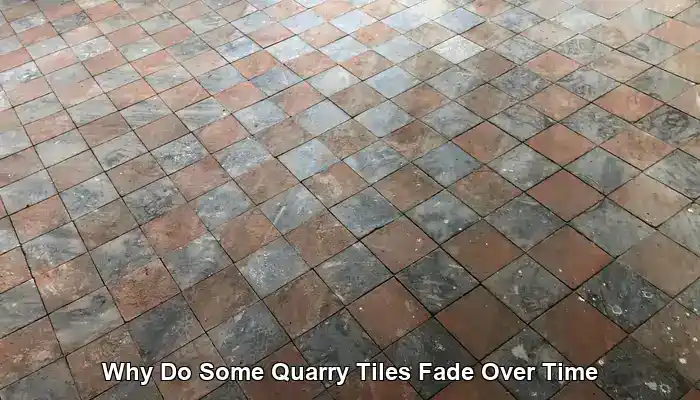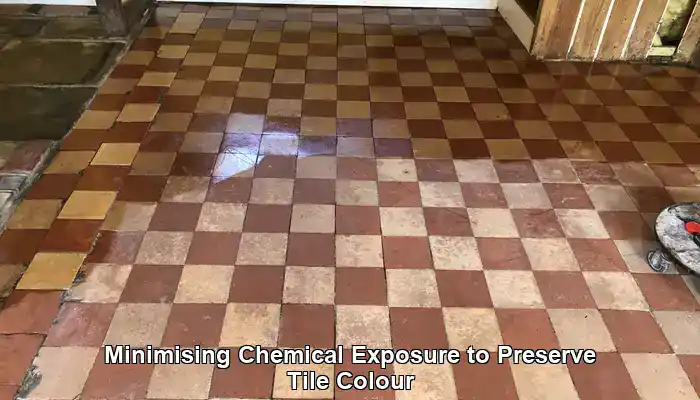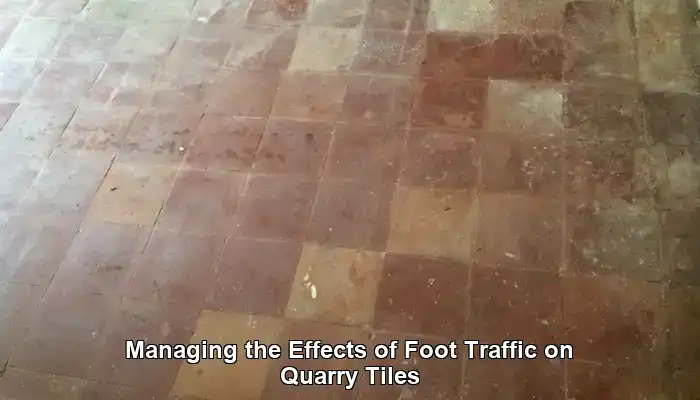
Why Do Some Quarry Tiles Fade Over Time: A Guide
Quarry tiles have long been admired for their durability, earthy charm, and timeless appeal. Whether laid across a rustic kitchen floor or forming the foundation of a sun-drenched patio, these dense, unglazed ceramic tiles are built to withstand heavy use and harsh conditions. Yet, despite their reputation for resilience, many homeowners and property managers notice a gradual fading of colour over time, sometimes uneven, sometimes dramatic. This change can be perplexing, especially when tiles that once boasted rich reds, warm browns, or deep terracottas begin to look pale, patchy, or dull.
The fading of quarry tiles is not merely a cosmetic issue; it often signals underlying wear, environmental stress, or chemical damage. Outdoors, tiles are exposed to relentless weathering—rain, frost, and temperature fluctuations that slowly erode the surface. The freeze-thaw cycle, in particular, can cause micro-cracks and surface spalling, revealing lighter inner layers with coarser textures. Indoors, the story is different but no less complex. High foot traffic gradually wears away the tile’s pigmented crust, exposing the inner body, which may contain larger particles and different mineral hues. This natural layering means that once the surface is compromised, the colour and texture can shift noticeably.
Beyond physical wear, chemical exposure plays a significant role. Strong cleaning agents, especially acidic or alkaline solutions, can degrade sealers and strip away protective coatings. Over time, this leaves the tile vulnerable to staining, efflorescence (salt deposits that lighten the surface), and soil accumulation in newly formed pits and abrasions. These factors combine to create a faded, uneven appearance that detracts from the tile’s original beauty.
Understanding why quarry tiles fade is the first step toward preserving their character and extending their lifespan. In this article, we’ll explore the environmental, mechanical, and chemical causes of fading—both indoors and out—and offer practical advice for prevention and restoration. Whether you’re maintaining a heritage floor or simply want to keep your tiles looking their best, this guide will help you decode the subtle science behind quarry tile wear.
Pro Tip: We recommend these products for daily Quarry maintenance cleaning.

Fila Pro Floor Cleaner
|

LTP Floorshine
|

Vileda H2PrO Spin Mop System
|
Outdoor Factors Affecting Quarry Tile Fading
Quarry tiles installed outdoors face a relentless barrage of environmental stressors that gradually erode their colour and texture. While these tiles are known for their toughness, nature has a way of wearing down even the most resilient surfaces over time.
Weather Exposure
One of the most significant contributors to fading is the weather, especially rain and freeze-thaw cycles. Rainwater can seep into the porous surface of unsealed or poorly sealed tiles, carrying minerals and contaminants that stain or leach colour. When temperatures drop, trapped moisture expands as it freezes, causing micro-cracks and surface flaking. This repeated freeze-thaw action exposes the inner body of the tile, which often contains lighter, less pigmented material.
Surface Wear and Layer Exposure
Quarry tiles are typically formed with a dense outer crust that holds the strongest colour. As this crust wears away—due to foot traffic, abrasion, or erosion—the inner layer becomes visible. This layer tends to be rougher, with larger aggregate particles and a lighter, more uneven hue. The result is a patchy appearance that lacks the richness of the original surface.
Chemical Damage
Outdoor cleaning often involves powerful chemicals to tackle moss, algae, or grime. Unfortunately, these strong solutions can degrade sealers and strip away protective coatings. Once the sealer is compromised, the tile becomes more vulnerable to staining, mineral deposits, and accelerated wear. Over time, this chemical exposure contributes to fading and surface dullness.
Indoor Factors Contributing to Quarry Tile Fading

While outdoor quarry tiles battle the elements, indoor tiles face a different set of challenges that can be just as damaging over time. From foot traffic to cleaning routines, the fading of indoor quarry tiles is often a slow, cumulative process driven by wear, surface breakdown, and chemical exposure.
Abrasive Wear and Crust Loss
Quarry tiles are manufactured with a dense, pigmented outer crust that gives them their rich colour and smooth finish. Indoors, especially in high-traffic areas like kitchens, hallways, and commercial spaces, this crust gradually wears away. As the surface erodes, the inner body of the tile becomes exposed. This inner layer typically contains larger mineral particles and a more porous structure, resulting in a noticeable shift in colour and texture. Earth-toned tiles may begin to look mottled or washed out, with lighter patches where the crust has worn thin.
Surface Pitting and Soil Accumulation
As the surface wears, micro-abrasions and pits begin to form. These tiny indentations act like traps for soil, grease, and cleaning residues. Over time, the accumulation of grime in these pits creates uneven staining and dullness. Even regular cleaning may not fully remove embedded dirt, leading to a faded, blotchy appearance. This is especially common in older floors that haven’t been properly sealed or maintained.
Efflorescence and Mineral Migration
Efflorescence is another culprit in indoor tile fading. This phenomenon occurs when moisture beneath the tile migrates upward, carrying soluble salts to the surface. As the water evaporates, it leaves behind a white, powdery residue that lightens the tile’s appearance and can cause surface damage. Efflorescence is particularly common in areas with poor subfloor ventilation or where tiles are laid over damp concrete. If left untreated, it can degrade the tile’s surface and make cleaning more difficult.
Chemical Overuse and Sealer Breakdown
Indoor cleaning routines often rely on strong chemical agents—especially in commercial or food preparation areas. While these products may be effective at removing grease and stains, they can also strip away sealers and protective coatings. Once the sealer is compromised, the tile becomes more porous and susceptible to staining, wear, and further fading. Acidic or alkaline cleaners can even etch the surface, altering its texture and colour permanently. Over time, repeated exposure to harsh chemicals accelerates the breakdown of both the tile and its finish.
Maintenance Practices That Matter
The fading of indoor quarry tiles is often preventable with proper care. Using pH-neutral cleaners, maintaining a regular sealing schedule, and avoiding abrasive tools can significantly extend the life and appearance of the tiles. For older floors showing signs of wear, professional restoration—including deep cleaning, re-sealing, and colour enhancement—can help revive their original beauty.
Prevention and Restoration Tips

Understanding why quarry tiles fade is only half the battle—the real value lies in knowing how to prevent it and restore their original beauty when wear inevitably sets in. Whether your tiles are laid indoors or out, proactive care and thoughtful restoration can dramatically extend their lifespan and preserve their rich, earthy character.
Sealing: The First Line of Defence
One of the most effective ways to prevent fading is proper sealing. Quarry tiles are naturally porous, and without a protective barrier, they readily absorb moisture, dirt, and chemicals. A high-quality penetrating sealer fills the pores without creating a surface film, allowing the tile to breathe while repelling contaminants. For outdoor tiles, this is especially crucial to guard against rain, frost, and algae. Indoors, sealing helps resist staining from spills, cleaning products, and foot traffic.
Sealers should be reapplied periodically—typically every 1 to 3 years depending on usage and exposure. A simple water-drop test can help determine when resealing is needed: if water soaks in rather than beads on the surface, it’s time for a refresh.
Cleaning Wisely: Avoid Harsh Chemicals
Routine cleaning is essential, but the products you use matter. Harsh chemicals, especially acidic or alkaline cleaners, can degrade sealers and etch the tile surface. Over time, this leads to dullness, discolouration, and increased vulnerability to staining. Instead, opt for pH-neutral cleaners designed specifically for stone or tile surfaces. These gently lift dirt without compromising the tile’s integrity.
For stubborn grime or efflorescence, use targeted treatments sparingly and always follow with a thorough rinse. Avoid bleach, ammonia, and vinegar-based solutions, which may seem effective but can cause long-term damage.
Maintenance Techniques That Preserve Colour
Regular sweeping and damp mopping help prevent soil buildup and surface abrasion. Use soft-bristle brushes or microfiber pads rather than abrasive scrubbers, which can wear down the tile’s pigmented crust. In high-traffic areas, consider using rugs or mats to reduce direct wear—especially near entryways or kitchen workstations.
For outdoor tiles, pressure washing should be approached with caution. While it can remove surface dirt, excessive pressure may erode the tile or force water into cracks, accelerating freeze-thaw damage. If used, keep the pressure low and the nozzle at a safe distance.
Professional Restoration: Bringing Tiles Back to Life
When fading becomes noticeable and routine care isn’t enough, professional restoration can make a dramatic difference. Restoration specialists use a combination of deep cleaning, mechanical resurfacing, and colour enhancement techniques to revive tired tiles.
- Deep cleaning removes embedded dirt, grease, and mineral deposits using specialised equipment and solutions.
- Mechanical honing or polishing smooths worn surfaces and restores texture, especially on indoor tiles with surface pitting.
- Colour enhancement sealers can enrich faded tones, especially in earth-coloured tiles, by deepening the natural pigments without creating a glossy finish.
In cases of severe wear, restoration may also involve regrouting, tile replacement, or applying protective coatings tailored to the tile’s environment.
Long-Term Care Strategy
Preventing future fading requires a long-term mindset. Establish a maintenance schedule that includes regular inspection, cleaning, and resealing. Educate household members or staff on proper cleaning techniques and the importance of using appropriate products. For commercial spaces, consider working with a floor care professional to develop a tailored plan based on traffic levels and environmental conditions.
If your tiles are part of a heritage property or have historical value, consult with conservation experts before undertaking any restoration. Preserving the authenticity of older quarry tiles often requires specialised techniques and materials.
Conclusion
Quarry tiles are celebrated for their rugged beauty and enduring charm, but even the toughest materials are not immune to the passage of time. Whether exposed to the harshness of outdoor weather or the constant wear of indoor foot traffic, fading is a natural consequence of environmental stress, mechanical abrasion, and chemical exposure. From the erosion of the tile’s pigmented crust to the subtle effects of efflorescence and surface pitting, each factor plays a role in diminishing the tile’s original vibrancy.
Fortunately, fading doesn’t have to be permanent. With the right knowledge and care—regular sealing, gentle cleaning, and professional restoration when needed—quarry tiles can retain their colour and character for decades. Understanding the causes of fading empowers homeowners, property managers, and restoration specialists to take proactive steps that preserve both the aesthetic and structural integrity of these timeless surfaces.
Whether your tiles are part of a heritage property or a modern installation, their longevity depends on how well they’re maintained. By respecting the material and responding to its needs, you ensure that your quarry tiles continue to tell their story—rich in colour, texture, and history—for years to come.
Frequently Asked Questions about Quarry Tile Care
Can faded quarry tiles be restored effectively?
Yes, quarry tiles can often be restored through deep cleaning, resealing, or even professional refinishing techniques, depending on the extent of the fading. Homeowners should explore their options for restoring the beauty of their tiles.
What is the recommended frequency for cleaning quarry tiles?
Regular sweeping should be performed weekly, with deeper cleaning every few months to maintain their appearance and prevent fading. Establishing a routine will help protect their vibrancy.
Are there specific sealants designed for quarry tiles?
Yes, there are specialised sealants formulated specifically for quarry tiles that offer protection against moisture and UV rays, enhancing their longevity and appearance. Homeowners should consult professionals for recommendations.
What cleaning products should be avoided on quarry tiles?
Avoid using acidic cleaners, harsh chemicals, and abrasive scrubbers, as these can damage the surface and contribute to fading. Opt for gentle, tile-safe products instead.
How can I tell if my quarry tiles need resealing?
If water no longer beads on the surface or if tiles appear dull and stained, it may be time to reseal. Regular checks can help maintain optimal protection.
Does indoor lighting affect the fading of tiles?
Indirect indoor lighting generally has less impact than UV rays, but prolonged exposure to bright light can contribute to gradual fading. Homeowners should consider lighting options when designing spaces.
Can I use a steam cleaner on quarry tiles?
Steam cleaners can be too harsh for quarry tiles, potentially damaging their surface. It’s best to adhere to recommended cleaning methods to maintain their integrity.
Are some quarry tiles more prone to fading than others?
Yes, tiles made from lower-quality materials or pigments may fade more quickly compared to those made from superior materials. Homeowners should prioritise quality.
Does foot traffic significantly affect the lifespan of quarry tiles?
High foot traffic can lead to wear and tear, accelerating fading and increasing the need for maintenance. Homeowners should adopt strategies to manage foot traffic effectively.
Is it possible to completely prevent fading in quarry tiles?
While it is challenging to prevent fading entirely, regular maintenance, proper sealing, and selecting quality products can significantly minimise colour loss over time.
9 Hazel Avenue
Lenzie
Glasgow
G66 4RR
07533-873-476
Copyright © Abbey Floor Care.
We are proud to be your local stone floor cleaning, polishing, and restoration specialists for homes and commercial properties in Central Scotland.
With years of experience working with all types of stone floors, our friendly and professional stone floor cleaning services can’t be beaten on price or service.
FAQ - Privacy Policy - Terms And Conditions
Abbey Floor Care is a participant in the Amazon Services LLC Associates Programme, an affiliate advertising programme designed to provide a means for websites to earn advertising fees by linking to Amazon.co.uk. As an Amazon Associate, we earn from qualifying purchases.